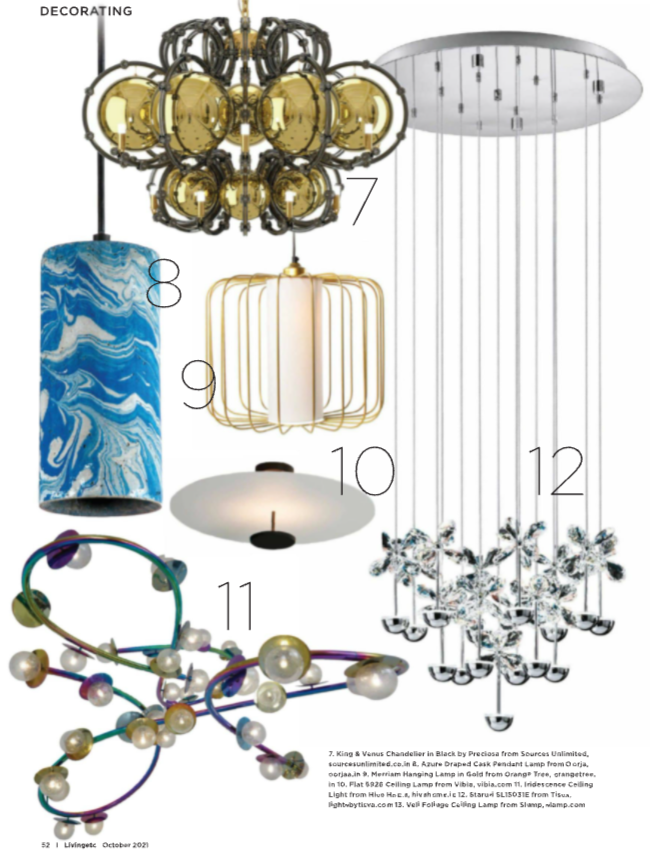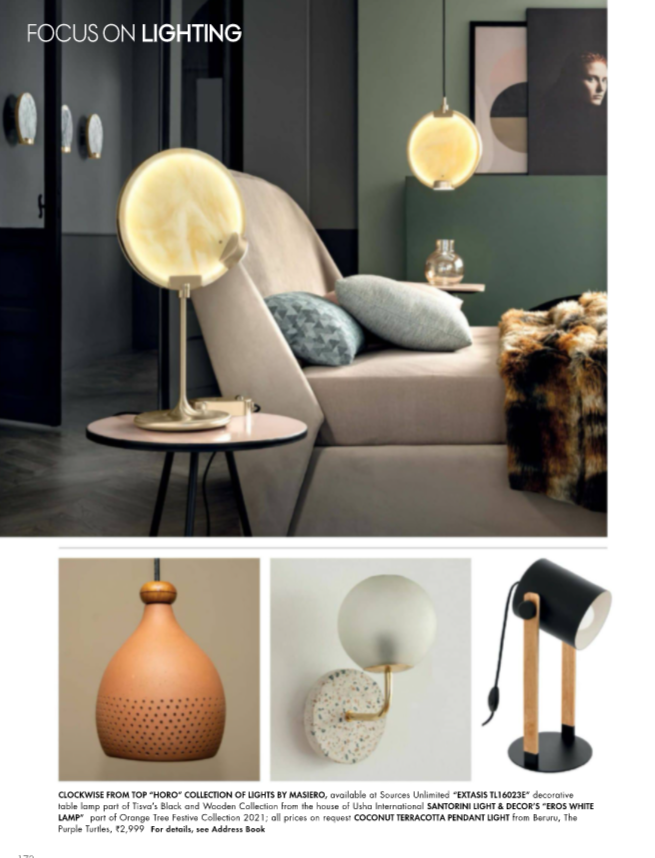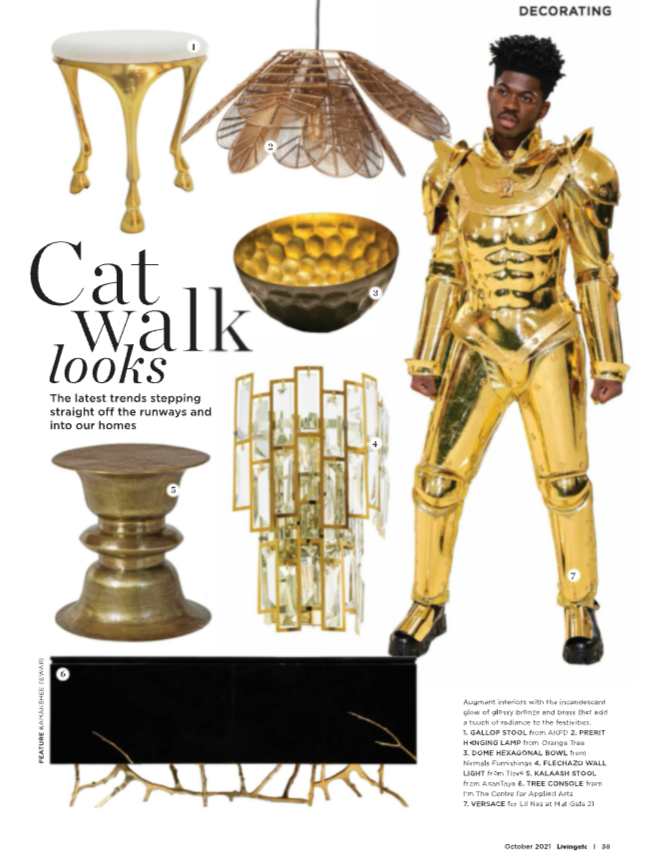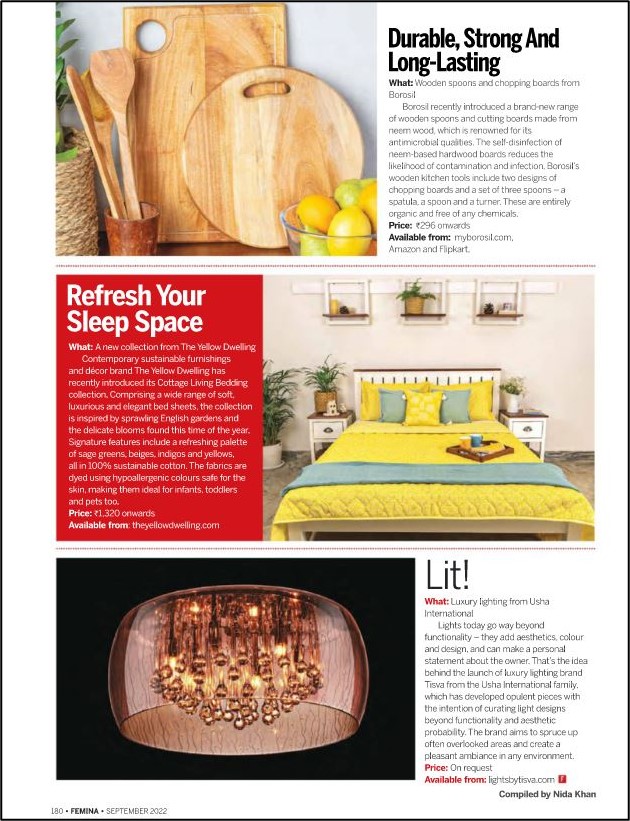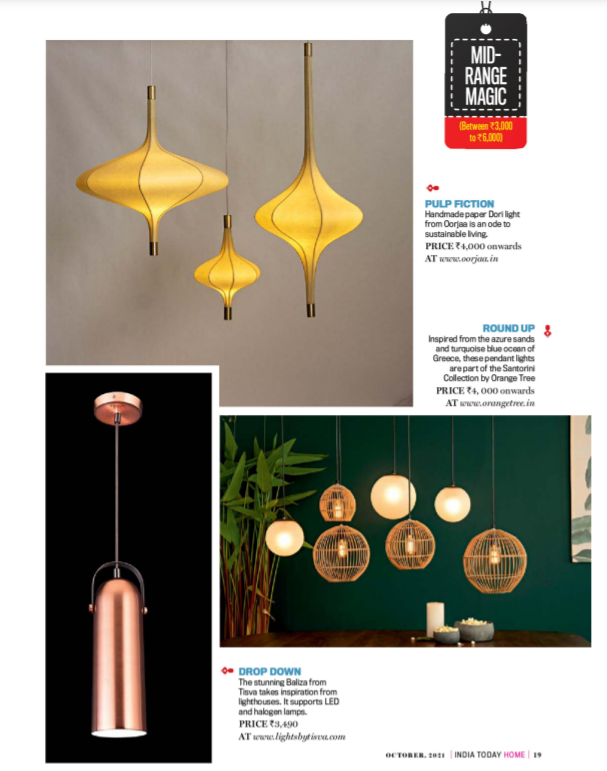The light distribution and electricity circuits to the lamp/light source embedded within it. They also provide support to the lamp. The luminarie directs light to where it is needed in terms of distribution and shields the light source from causing glares.
Luminaries thus are composed of many parts, each part carrying out a specific function. The three basic parts are the Housing, Light Control element and glare Control element. At times these functions may be combined, depending on the design of the luminarie.
Housings
The Housing provides physical support and electricity to the lamp. There are five different types of Housing, based on how they are fixed or supported.
Recessed Housings: These kinds of housings are mounted above the ceiling and thus remain out of sight. The Ceiling features gaps and holes for light to pass through. Some of these housings can also be used for floor and wall lighting –concealed inside walls and below floors. The electric connection between the house and the luminarie in such systems are located in a Junction Box adjacent to the luminarie.
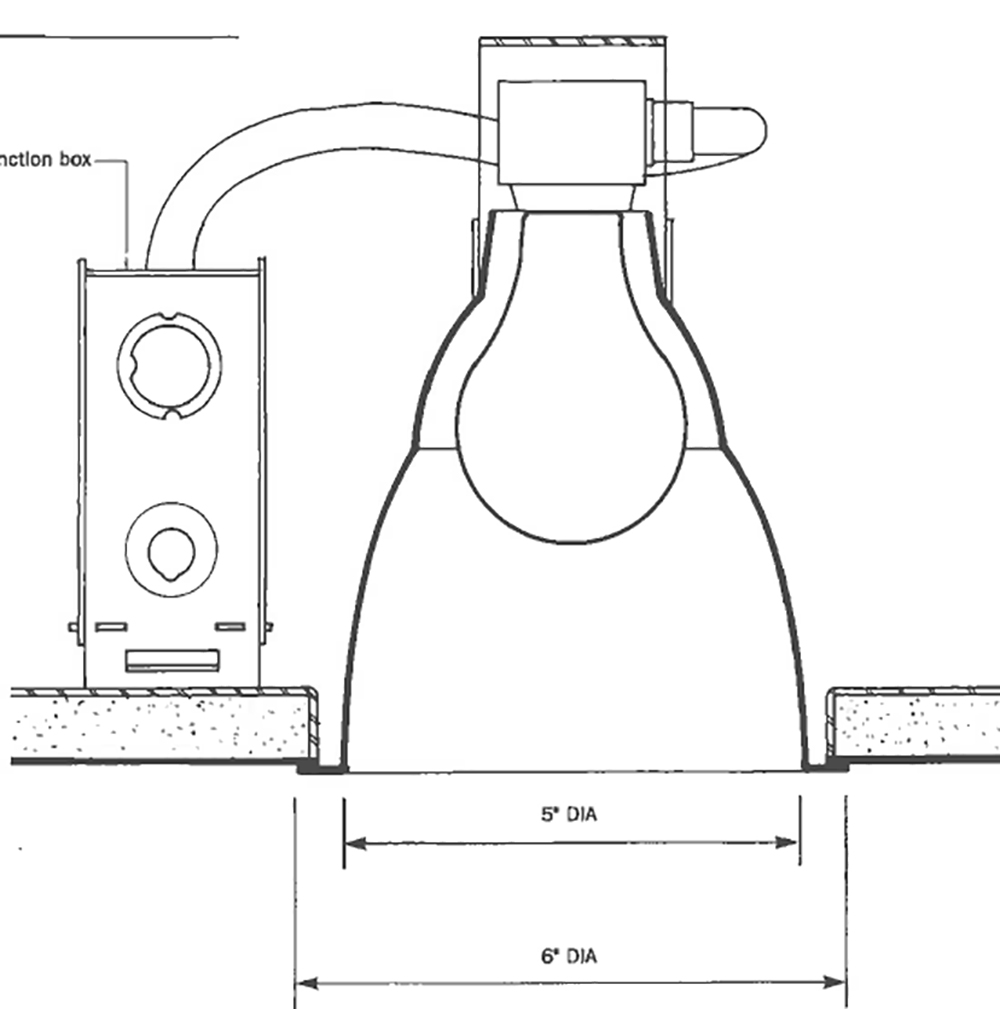
Semi-recessed Housings: In these systems the housings are partly visible, with some of it located beyond the ceiling and the rest being visible below the ceiling.
Surface mounted Housings: These Housings are mounted on the surface of the ceiling, and are visible. The Junction box can be fixed beyond the wall or on the surface. Since these housings are visible they become a design element of the luminarie.
Pendant- Mounted Housings: These can either use a concealed semi-recessed unit or a surface mounted unit for the junction box (where the wiring of house is connected to the lamp’s circuit). In addition to this the luminarie is separated like a pendant from the ceiling via chain, chord, etc.
Track Mounted Housings: This type of housings can feature a recessed, semi-recessed or a surface mounted track. This track provides both support and electricity to the lamps fixed to it. This type of system is generally used in museums or exhibits where certain objects need to be highlighted.
Light and Glare Control
On the basis of their light and glare control elements luminaries can be divided into five categories: Downlighters, Wash lights, Object Lights, Task lights and Multidirectional lights.
Downlighters
Also known as direct luminaries they provide symmetrical light focused downwards. A number of Dowlighters can be used to light up a hall; they can also be used to highlight certain object or task area horizontally.
Point Source Downlights
Reflectors often feature a non-directional and concentrated light source. Almost all reflectors have a round apertures.
In Open-reflector Downlights a reflector controls the distribution and glare of the light source/ lamp. Such luminarie systems allow inexpensive and easily available A-Lamps (bulbs) to be used as Downlights. Similar reflectors are used to turn Tungsten-halogen bulbs, compact florescent and HID lamps into downlighters. The only difference being that florescent and HID lamps feature bigger apertures, as the light source is bigger in them.
High Hats and Cans are cheaper versions of Open-Reflector downlighters, though more economical their light distribution and glare control is very poor. Similarly Ellipsodial downlighters are bad at directing light downwards but good at glare control. They also happen to be too large.
Shallow Contour Open Reflectors Downlights allow downward diffusion of light and also creates sparkles on the ceiling. The sparkles appear due to the luminarie’s pebbled surface reflector. These lamps have a silver reflecting bowl which throws light upwards towards the luminarie’s reflector which in turn directs the light downwards.
Directional- Source Downlights do not require a light-control element, as these lamps come equipped with such systems. Lamps under this category are AR, MR, PAR, and R lamps. They however at times require brightness control systems, which can be added via the open parabolic reflector.
R14, R 20, PAR 16 and PAR20 lamps are used when a narrow beam of light is required along with spot lights, with the latter two lamp types being more efficient. R lamps provide a wider beam compared to PAR lamps. R30 and R40 lamps should never be used for downlighters.
Reflectors:
Specular Aluminum Reflectors are the most efficient, when it comes to beam control, with semi-specular reflectors being a little less efficient but they manage to remove all irregularities in the light. Also slight diffusion occurs in semi-specular reflectors, making them look brighter.
Both these reflectors must be treated like fine-glass, as dirt, fingerprints and scratches will spoil their appearance. Thus they must be cleaned with soft clothes at regular intervals.
Rectilliner Fluorescent Downlights.
Based on the same principal as Incandescent downlights, Fluorescent Downlighters use either rapid-strat T8, T12 or long compact sources.
Shielding: Shielding is most important component in Fluorescent Downlights as it is prominently visible. Diffusers, lenses and louvers used for this purpose function by redirecting light from the glare zone towards the work plane. But almost all such shields in fluorescent lights fail to reduce their luminance sufficiently to provide visual comfort. Sometimes the excessive contrast between the lens and ceiling also create distraction. Parabolic louvers are able to control luminance precisely, whereas Small-cell parabolic louvers reduce luminance but are inefficient in light output. However it is the Deep-cell open parabolic louvers that provide the best combination of shielding and efficiency.
Spacing Criterion: Manufactures at times do publish the Downlighter’s Spacing criterion (SC). This is the estimated distance between two mounting points. SC is a low precision indicator; it simply helps designers to assess the lamp quickly. SC views are at times even given for Uplights, but very rarely for washers, object lights, multidirectional lights etc.
Luminous Ceiling: A luminous ceiling also provides direct downward distribution of light. It consists of a plane of translucent glass or plastic below the fluorescent light. These types of ceilings were generally used in the 1950’s- 1960’s and often covered the entire area of the room. Their major drawback being that they light everything from all directions without shadows creating a low-efficiency environment.
Wash Lights
These are lights that provide an even ‘wash’ or layer of light over an area; they are used mostly for walls and occasionally for ceiling lighting. In rooms of moderate size, the wall is the most prominent feature hence it is necessary to light it in a creative way.
To minimize specular reflection at the top of the vertical surfaces, it is necessary that these lights have a matte finish. Also specular surfaces like mirrors and marbles on walls cannot be lighted as they will reflect back light to the floor.
Walls are lighted in two ways: 1. Using a row of individual asymmetrical lamps placed parallel to the wall, and at a distance of about 1/3 the height of the wall, where even the individual units are placed with the same in-between distance (1/3 height of wall). 2. A system of linear closely placed directional light sources.
Asymmetric Wall-washers: These sources are generally used to light up paintings or to create a sense of space along the walls. These lamps use reflectors or directional lamps or both and frequently use lenses to spread the light. These lamps fall into two categories: Downlight/Wall-washers and Reflector Wall-washers.
Downlight/Wall-washers: These are a special kind of wall-washers consisting of a parabolic open-reflector downlight with an elliptical reflector (also called a kicker, as it kicks light up towards the top of the wall). Downlighters without the kicker can be used for general room illumination. Various types of Downlight/Wall-washers are available: Lights that can be used to light opposite sides of a corridor (Downlight/Double Wall-Washer), lamps to light adjacent walls and corners (Downlight/Corner wall-washer) and lamps to illuminate a wall next to a door, without lighting the door (Downlight/half wall-washer).
Reflector Wall-Washer: These types of lights only illuminate the vertical surface without any significant downward distribution and come with sophisticated luminance control systems. There are two types of Reflector Wall-Washers – Lensed wall-washers and open-reflector wall-washers. Lensed Wall-washers consists of a directional source of light, an internal kicker reflector, a spread lens and a brightness-controlling reflector to shield glare. Such wall-washers are available for Tungsten-Halogen MR and PAR, Compact fluorescent, metal halide and HPS lamps.
Open-Reflectors either feature a compound-contour shape – a combination of an ellipse and a parabola – or use non-focal shapes. Reflectors that are not circular, parabolic, elliptical or hyperbolic are non-focal reflectors.
Lensed and Open-Reflector Wall-washers when used without Downlights create a shadowless, low-contrast setting. People near the light source appear silhouettes, while people far away appear flat.
Wall-washing can also be done through a diffuse-source fluorescent lamp. This however creates a bright area at the top of the wall with light fading downwards along the wall. By adding a reflector with wide-aperture, this problem can be solved. Fluorescent Wall-wash systems are also called Perimeter wall-wash systems.
Linear Wall-Washers: These washers are located on the ceiling just next to the wall. They de-emphasize the ceiling and highlight the vertical surface-wall, drapes, art-work etc.
Incandescent Systems: A continuous series of directional lamp sources mounted on a repetitive spacing can be used to wash wall with light. The multiple beams from the series of lamps overlap producing uniform brightness.
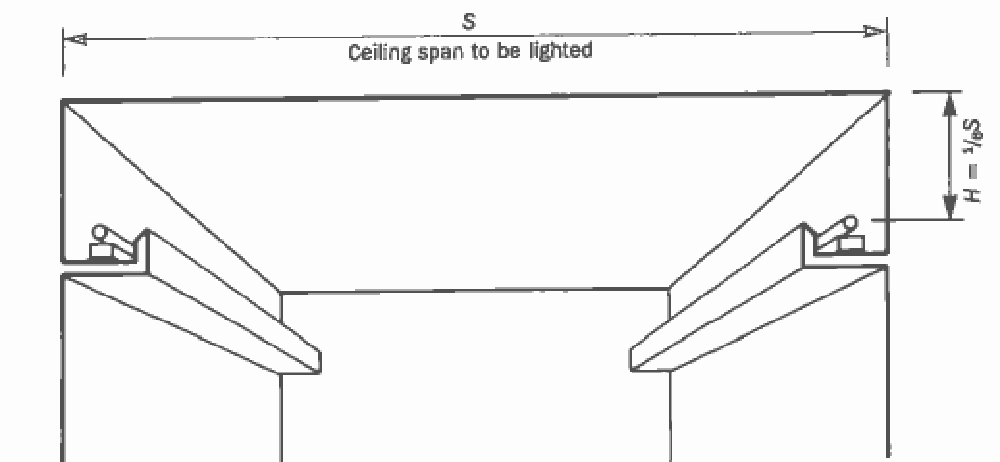
Fluorescent Lamps: Even with sophisticated reflectors Fluorescent lamps have a hard time projecting a high intensity lights towards the bottom of a lamp. When using fluorescent sources with reflectors to wash walls, they need to be placed at a distance ¼ the height of the wall, from the lit surface. Luminance at the bottom will be 1/10 the luminance at the top. If the light source is placed closer than the ¼ distance it is called grazing light and will highlight the texture of the wall/art-work etc but it will also make irregularities more prominent. By adding a frontal light this problem can be resolved. When lighting opposite walls the light sources need to be placed at a distance of 1/6 the height of the wall.
Fluorescent lights are usually used to wash wall in rooms with low ceilings and placement of overhead equipment proves difficult. Still care should be taken to control glare. And placing them too close to the wall will make the wall appear brighter than the light source.
Lighting the Ceiling Plane
Just as Wall-washers light up vertical surfaces, devices known as Uplights and indirect luminaries are used to illuminate ceilings. These are suspended from the ceiling by stems or cables, mounted on top of furniture above eye-level, attached to walls etc. A few of these only use indirect light; they are usually stem-mounted and contains a downlight component.
Uplights: Fluorescent uplights were developed primarily to provide even illumination to the ceiling without variations. Other point-source directional luminaries are also used for this purpose. Uplights are suitable for high ceilings, which allows luminaries to be mounted high above avoiding ‘hot spots’. If mounted too low they will create variance and discomfort. Research indicates that if people can see the source of light, they perceive higher brightness. Pendants and visible light sources thus help to create this illusion, whereas dark or invisible sources cause lower illuminance perception.
Furniture mounted Uplights are placed above eye-level to avoid glares. Wall or Celing mounted Uplights create asymmetrical distribution of light like Wall-washers.
Architectural Coves: These are an architectural feature that provides general ambient-light to high ceilings. Like wall-washers this systems direct light towards large areas of the ceiling. This is a more energy effective lighting solution. Coves can be made of wood, plastic or metal, adding a plastic or glass bottom will create sparkles towards the bottom. To minimize specular reflection the ceiling should have high-reflectance being made of matte or satin finish.
Fluorescent lamps or Cold Cathodes lamps are usually used in such systems, as they are efficient and have a linear source. All lamps used here much have the same colour and diameter to avoid variations. When these lamps are mounted along a series, a gap will occur where the lamp holders are placed, hence it is recommended that they be mounted without any gaps where lamps overlap each other by three inches.
If due to space constraints the cove is located too close to the wall, nearby surfaces will appear too bright. This can be avoided by adding a shield to the cove, so that it prevents light from reaching the upper wall. To achieve uniform lighting the lamps must be placed at a height of 1/6 the distance between the two opposite lamps.
Object Lights
Adjustable Object light also mistakenly called ‘accent lights’ provides symmetric distribution of light over an object or objects. They are used to provide focal glow and a contrast setting, highlighting the object. They use a directional light source like AR, MR, PAR or R lamps and are also called ‘Spot light’. These lights may feature horizontal rotation stop to prevent wires from tangling. Generally the vertical adjustment in these lights range between 0 to 35-45 degrees. Surface mounted or Pendants are more versatile with a higher range of vertical adjustment. Track-mounted luminaries are designed to rotate slightly more than 360 degrees.
It is designed to hide direct view via shielding, without affecting the light beam. Luminaries that come with brightness control make ideal Object lights. This can be achieved through louvers, pendants, Cross Baffles and other recessed equipment – of these Cross-baffles are the most efficient with little loss of light. Louvers reduce illumination by 50 percent.
Lamps used for highlighting Art-works come with a linear spread lens that soften the edges of the beam and highlights the object. Lamps without this feature will light the entire space equally.
Task Lights
These are light sources that are placed close to the illuminated surface and are used on work surfaces. Local task lights prevent reflection and are often energy-effective. Since they are placed near the work surface they consume less power, by using lamps with lower watts/voltage. Ideal for deskwork, these luminaries at times may cause veiling reflections. This can be avoided by using optical lenses. Adjustable Task luminaries such as Table lamps can be used very efficiently.
Soffits: These are a type of Task Lights that are located adjacent to a vertical surface like a wall. The top is generally closed, and all light is directed downwards. Adding a Reflector (open louvers or etched plastic/glass) will increase useful light. While a Matte finish work surface will minimize specular reflections. For make-up and grooming areas a translucent diffusing panel will light up faces from many directions. Low Brackets are used to light special areas like countertops and reading surfaces.
Multidirectional Luminaries:
Direct-Indirect Luminaries: These are a combination of downlight (direct light) and uplight (indirect lighting). The sharper shapes created by direct lighting are softened by the indirect light. Also increased ceiling luminance results in greater diffusion, while inter-reflections reduce variations on the ceiling.
Valances: Valances are used over windows, art-work or other such special lighting needs. They provide both in-direct uplight that reflects back from the ceiling for ambient lighting and downward wash-light to highlight drapes, artworks etc.
High Brackets: These are used on windowless walls and provide both uplight and downlight highlighting surfaces and art-works.
Decorative luminaries: They are used to provide ambient lighting in areas where their decorative features contributes to the space aesthetically. They are available in many types: Ceiling mounted, Wall lights, pendants, surface mounted, chandeliers, floor mounted, track lights etc.
Almost all decorative luminaries are multidirectional sources; and a few have hidden internal optical control to provide specific direction to the beam.


